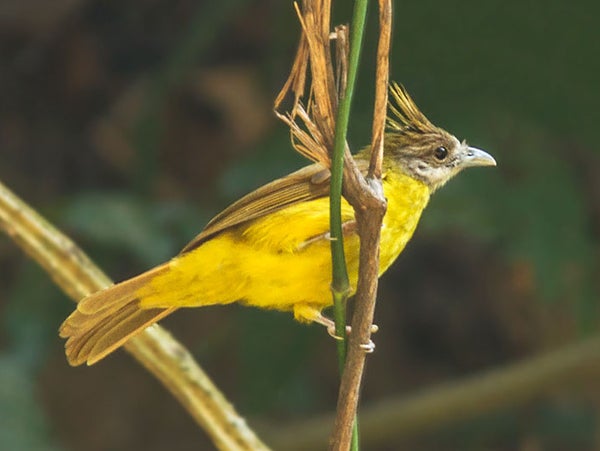This article was published in Scientific American’s former blog network and reflects the views of the author, not necessarily those of Scientific American
According to conservation groups, we probably shouldn’t be all that worried about a wide-ranging Asian bird species called the white-throated bulbul (Alophoixus flaveolus).
“This species has a very large range,” says the bulbul’s conservation assessment in the IUCN Red List of Threatened Species. Although the species’ population size has never been evaluated, it has a known range of more than 560,000 square kilometers. With that much habitat at its disposal, the species must be doing okay, right?
Not so fast. According to data in a paper published last week in Science Advances, the white-throated bulbul may really have a distribution that extensive, but the actual amount of habitat available to it within that range is actually much, much smaller. If you take into account such details as elevation and deforestation, it turns out that this bird only has 5,827 square kilometers of suitable habitat left—about 1 percent of what had previously be assessed.
On supporting science journalism
If you're enjoying this article, consider supporting our award-winning journalism by subscribing. By purchasing a subscription you are helping to ensure the future of impactful stories about the discoveries and ideas shaping our world today.
The white-throated bulbul is not alone. According to the paper, hundreds of bird species in six of the world’s most biodiverse regions have much smaller levels of suitable habitat available to them than previously recognized. Of the nearly 600 species the researchers studied for the paper, they estimated that 189 species not currently assessed as being at risk may actually be threatened, some critically so.
How did they come up with these conclusions? The researchers used remote sensing—satellite scans of the Earth—to determine where forest habitats have been lost to agriculture, urbanization or other land-use changes. They also classified the areas by elevation, a critical element of where many bird species choose to live.
This type of technological assessment, the authors said, is not currently used when assessing species risk in the IUCN Red List, to which conservation groups and researchers around the world contribute.
“Good as it is, the Red List assessment process dates back 25 years and does not make use of advances in geospatial technologies,” senior author Stuart L. Pimm of Duke University said in a prepared statement. Although he praised the IUCN Red List for its transparency and rigorous criteria, he says it has fallen short as technology has progressed. “We have powerful new tools at our fingertips, including vastly improved digital maps, regular global assessments of land use changes from satellite images, and maps showing which areas of the planet are protected by national parks.”
Although the IUCN itself has disputed these findings, saying current methods do the trick, the paper does highlight the fact that we need to step up our game in our attempts to understand the threats the world’s species currently face. As habitat loss accelerates around the world, many species could suffer or even disappear before we truly have a chance to figure out how urbanization and other threats impact them. New tools and technologies can only serve to contribute and help us to adapt before it’s too late—for the white-throated bulbul or hundreds of other species.
Previously in Extinction Countdown:
